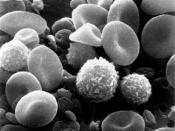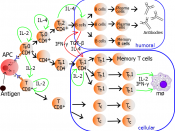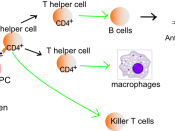The immune system is a group of cells, molecules, and tissues that help defend the body against diseases and other harmful invaders. The immune system provides protection against a variety of potentially damaging substances that can invade the body. These substances include disease-causing organisms, such as bacteria, fungi, parasites, and viruses.
The first line of defense against foreign invaders is innate immunity. Innate immunity encompasses skin, and the respiratory system, which also contains mucus that traps and destroys invaders. This type of Immunity destroys any foreign invader before the onset of symptoms. When any invader gets passed the skin a person must use their acquired immunity, to help fight off the invader. This immunity either comes from having been attack by the invader before and already having antibodies, or it comes from receiving antibodies, i.e. a vaccine. If a certain invader has not attacked the body before the immune response is kicked in to full gear to help fight it off.
All foreign invaders have certain markers on them known as antigens. The antigens are what tell the body that in is in fact a foreign invader. If a person already has the antibodies for a certain antigen then the invader will be neutralized instantly, and then 'eaten' by a macrophage. As said if the antigen is new then a long process goes in to affect. There are two different responses, the Cellular response and the Humoral response.
The Humoral response starts when a macrophage sees and engulfs the invader. The macrophage then displays the antigens of the invader on itself. It then activates the helper T-cells. The helper T-cells recognize what the antigen(s) look like. The Helper T-cells then activate the B-cells. Also the Helper T-cells activate the Killer T-cells as part of the Cellular response. The B-cells...


